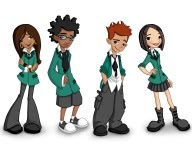To encourage successful expository readings, and possibly lessen that fourth grade slump, we referred to Ogle and Blachowicz's article in the 2002 Comprehension Instruction: Research-based Best Practices and compiled a list of storybook approaches that students can transfer to informational texts. Read on for classroom tips and Imagine Learning’s approach.
Study the pictures
Just as storybooks entertain kids with pictures on each page, expository texts are packed with tables, diagrams, maps, and photos that students can use find extra information.
- Classroom Tip: When introducing a new text, take students on a guided tour of the unique visual elements. Explain what captions are and encourage them to figure out how each photo or diagram helps tell a story, or prove the author’s main idea.
- ILE: To help students read charts and tables, check out the leveled texts Picture This and The Record Breakers in our Level 2 Review Menu. For help with time lines, read Create a Timeline and then Exploding Mountain. These articles not only explain how to interpret visual aids, but they also give students more exposure to informative text.
In between each page of an exciting story, kids question what happens next. Although informational texts are not structured in a story arch, students still gain valuable critical reading skills by asking meaningful questions.
- Classroom Tip: Ask your students to write down 5 questions after every article or chapter they read. These questions can go any direction, from questioning why an author included certain information to what important information might have been left out.
- ILE: Before each of our leveled books, students take a look at the cover and title with Alex, their Imagine Museum buddy. Alex asks questions about the title and guesses what the article might be about. This thought-modeling encourages students to do the same when they encounter a new text.
The same story can be told in very different ways depending on how it’s organized: think of a fairy tale in picture book form, then a chapter book, and finally a novel. It's the same with expository texts. Donna Ogle and Camille Blachowicz emphasize that "young readers need to know how informational texts are organized externally (table of contents, headings, chapters, etc.) and internally (text structure: problem-solution, cause-effect, and so forth."
- Classroom Tip: Pick a topic and bring several informational books on that topic, intentionally varied, to class. Divide the class in groups and give one book to each group. Ask the students to look at external features first: Are there any headings? Is there a glossary or index? Ask why these features might be helpful. Then move on to internal features. By pointing out how information is organized internally, students become sensitive to text structures and recognize them more easily in the future.
- ILE: After every article students read, they are given a graphic organizer. These printouts ask students to map the main idea with supporting details, identify a problem and solution or cause and effect, or organize the main points of the article in other ways.
Children must hear a myriad of stories before they understand the structure of a good story. They’ll need at least as many examples of expository text. The more encounters, the better.
- Classroom Tip: Everyday, share an interesting article you read that day. Take it from the newspaper, a magazine, the Internet—just make sure it’s varied and inviting. When they see all the fascinating facts you can learn, they’ll begin to wonder what they might find.
- ILE: Our leveled texts are read in pairs, with the first giving background information to prepare for the second. With scores of expository articles in the curriculum, students are exposed to a variety of topics and formats. And with all the scaffolding we provide, including clickable glossary words and pretaught vocabulary, students get all the experience they need to tackle exposition on their own.




No comments:
Post a Comment
Thanks for stopping by!